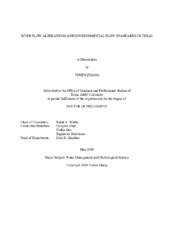| dc.description.abstract | River basin hydrology in Texas is characterized by extreme variability both spatially and temporally. Rapid population growth and declining groundwater supplies intensify demands on surface water resources. With enactment of the 2007 Senate Bill 3, the Texas Legislature mandated establishment of a process for creating and implementing environmental flow standards. The Texas Commission on Environmental Quality (TCEQ) is working with the water management community to establish environmental flow standards with subsistence, base, in-bank pulse and over-bank flow components for incorporation into the statewide water availability modeling system to protect environmental instream flows from intense water appropriation for human uses. The two objectives of this dissertation are (1) quantitative analyses and improved understanding of streamflow modifications, especially alterations of flow regimes that produce ecological change and (2) exploration of environmental flow standards via the water availability modeling (WAM) system. The Indicators of Hydrologic Alteration (IHA) statistical methods developed by the Nature Conservancy were employed to characterize streamflow hydrographs for the Sabine, Neches, Guadalupe-San Antonio, Trinity, Brazos, Colorado Rivers and their major tributaries. The TCEQ WAM System was applied to investigate various aspects of environmental flow standards in two case study river basins, the Brazos, Trinity, and Neches.
The IHA software was used to summarize long periods of daily hydrologic data into much more manageable series of ecologically relevant hydrologic parameters and was demonstrated to be a feasible approach for calculating the characteristics of natural and altered hydrologic regimes. The results show that long-term changes in observed flows are very different between river basins and sites, but changes appear to be relatively more evident downstream of major dams. The WAM simulation results as to reliability, frequency, and duration metrics related to SB3 environmental flow standards at selected sites in the Trinity, Neches, and Brazos River Basins test and illustrate strategies for modeling flow standards which are applicable in other basins as well. Different scenarios are simulated to assess potential capabilities for satisfying instream flow targets. Research results have been evaluated and summarized to assist scientists and decision-makers in establishing new flow standards and improving existing standards to avoid or mitigate impacts of water development on natural environmental resources. | en |


